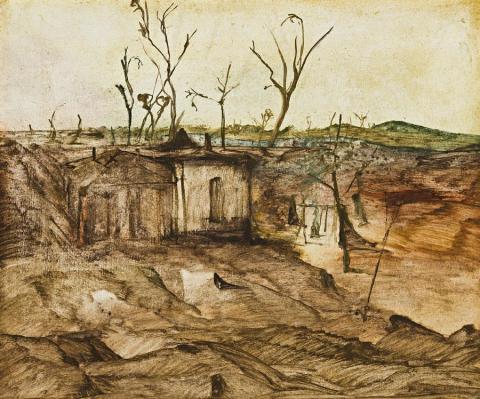OUTBACK, WESTERN QUEENSLAND, c.1948
Sidney Nolan
ripolin enamel and oil on composition board
62.5 x 74.5 cm
signed lower right: NOLAN
The Brian and Marjorie Johnston Collection, Queensland
Private collection, Sydney
Sotheby's, Sydney, 25 August 2003, lot 111
Private collection, Sydney
Sotheby's, Sydney, 22 April 2008, lot 67
Company collection, Melbourne
Philip Bacon Galleries, Brisbane, 1997
Following Sidney Nolan's journeying in Queensland in the latter part of 1947, there followed a spectacular outburst of paintings many of which today hold a highly respected place in the artist's oeuvre. The Mrs Kelly series, the beginning of the Burke and Wills paintings, and those witty paintings of country hotels, general stores and isolated mines with their bizarre birds are among the most memorable. The Art Gallery of New South Wales bought its first Nolan, Pretty Polly Mine 1948, and Sir Kenneth Clark acquired Little Dog Mine 1948, his visit to Nolan's studio marking the beginning of a lifelong friendship.
When Nolan held his Queensland Outback Paintings exhibition in Sydney in 1949, Harry Tatlock Miller wrote with discerning eye - 'I can remember no other exhibition by a contemporary Australian which, with such seemingly disarming innocence, reveals so much individuality of vision...'1 No matter how stark the landscapes, there were always signs of human presence, a theme that was to occupy Nolan at this time. To John Reed in Melbourne, Nolan wrote of, 'a continuity of experience from my own time back to the beginnings of settlement here. It is a thing I have struggled to see and perhaps for the first time have felt.'2
This freshness of vision and association with the land is clearly present in Nolan's Outback, Western Queensland c1948. The flatness of the picture plane is cleverly engaged to invoke the seemingly endless vastness of the outback, a part captured to record the scene and mood. The absence of depth within the composition is achieved largely through ascending images, even the land forms reach upwards rather than into the picture. This is repeated in the branches of the gums, linking the sky and ground as colours lock all into the overall surface emphasis. Like other Australian artists of perception and sensitivity, Nolan makes a virtue out of the apparent monotony of the landscape, revealing its subtleties within the sublime grandeur of our ancient land.
1. Miller, H. T., The Sun, Sydney, 8 March 1949, quoted in Clark, J., Sidney Nolan: Landscapes & Legends, International Cultural Corporation of Australia Limited, Sydney, 1987, p. 97
2. Nolan to John Reed, Brisbane, 18 September 1947, quoted in Clark, Ibid., p. 95
DAVID THOMAS
